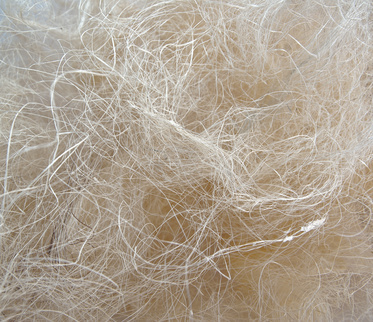 Raw material: The basic raw material of SETRALIT® - Fibre (Setralit - Wikipedia) is a non-wood natural fibre which is generally called “vegetable fibre”. In many cases this is a bast fibre like hemp, flax, nettle, kenaf, jute, or ramie, but leaf fibres like sisal or musa textiles (manilla hemp, abacá) or fruit fibre like coconut(coir) or cotton are also suited for ultrasonic treatment. In middle Europe we will mainly use hemp and flax. The material may be the whole plant, dried and coarsely broken, but also and more favourable, partly or completely decorticated meaning freed of the wooden plant constituents (shives).
Raw material: The basic raw material of SETRALIT® - Fibre (Setralit - Wikipedia) is a non-wood natural fibre which is generally called “vegetable fibre”. In many cases this is a bast fibre like hemp, flax, nettle, kenaf, jute, or ramie, but leaf fibres like sisal or musa textiles (manilla hemp, abacá) or fruit fibre like coconut(coir) or cotton are also suited for ultrasonic treatment. In middle Europe we will mainly use hemp and flax. The material may be the whole plant, dried and coarsely broken, but also and more favourable, partly or completely decorticated meaning freed of the wooden plant constituents (shives).
Ultrasonic treatment: The fibrous raw material is being exposed to an ultrasonic field in a watery medium for a time period between 10 and 120, usually 30 seconds. During this continuous procedure and subsequent washing the fibrous is being cleaned and extensively freed of attendants like dust, soluble organic components, micro organisms, colour and scent stuffs. The level of cleaning can be determined by adjusting the process-parameters.
Post-processing: As a rule immediately after treatment the fibre is being dried, opened and cleaned again. Shives and other coarse materials still attached as well as short fibres are being removed. The waste mixture mainly made of short fibres and shives can be regarded as a by-product.
Refinement: Following refining and finishing procedures are applicable on the cleaned ultrasound fibre material: cutting, grinding, fibrillating, and coating, which are being used alternatively or in a row. Cutting and grinding will shorten the fibres, fibrillation will amplify the specific surface. Coating can be useful to improve the binding attitudes of a fibre within a matrix (for example plastics). Additional possible refinement steps are bleaching, dyeing and mixing.